Duel F750 GS Vs Tracer 700: small trails, large road bikes ?

New distinct look, improved practical aspects, two-cylinder 689 cc to Euro5 standards: the Tracer 700 is evolving to confirm its success on "small" road trails. But do the new Yamaha and its rival BMW F750 GS have the necessary skills to embody the motorcycle to do everything (well) ? MNC duel.
Duel F750GS Vs Tracer 700 page 1: good all-rounders ?
A single motorcycle, several possibilities at a reasonable price: the Tracer 700 has been part of this versatile and accessible motorcycle register since 2016, without neglecting the sensations thanks to its joyful twin cylinder and its contained weight of 196 kg. Normal, since the Yamaha is actually an MT-07 roadster with a semi-fairing, a large handlebar and some road improvements !
- Video duel :
- MNC file :
- MNC file :
- MNC file :
This "small" trail-GT – which still cubs 689 cc – has its first Euro5 overhaul: its vertical twin meets new standards via work on the injection and the exhaust, while its transmission is shortened to boost its reminders and compensate for the slight drop in power (73.4 hp against 74.8 hp in 2019, torque identical to 68 Nm).
The Yamaha also releases – especially? – a particularly bold new look with its almond LED headlights and two lenticular optics, YZF-R1 style. Other modifications: its saddle now in one piece thickens (+5 mm), its handlebars widen (+34 mm), its LCD instrumentation – in white on a black background – can be operated with the left hand and its new bubble rises without tools to 64 mm. Added to this are new suspension calibrations aimed at obtaining a rigor that was sometimes lacking on the previous one..
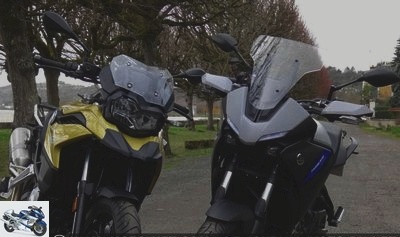
The F750 GS further justifies its name "trail" with its 19-inch wheel (17 on the Yamaha), its practical standard luggage rack and its wide handlebars (85 cm Vs 79). More sophisticated, it receives original traction control, an electronic accelerator and two maps (Rain and Road) which influence the response of its inline-twin 853 cc (164 cc more than the Tracer) designed in Germany but assembled in China by Loncin.
Good news: BMW now installs the superb 6.5-inch color TFT instrument panel with Bluetooth connection and GPS guidance via a dedicated app as standard, which was optional when MNC discovered it in spring 2018 (MNC video below ). Bad news: it is not a "gift from the house" since its price has gone from 9650 to 10,470 euros over the same period, without further evolution !
- MNC Smart-Video:
The price of the Yamaha is also increasing, but not in the same proportions: from 8,399 euros when it was released in 2016 to 8,799 euros today. Both are in any case legitimate to seek the title of "all-purpose motorcycle": those which are forgotten on the trips "work-sleep" but which give the smile during the escapades "virolos-à -gogo ". Slippers during the week and sneakers at the weekend, in short !
Position and protection: Yamaha advantage
The ergonomics of these two motorcycles differ quite notably: the Tracer 700 is a narrow and short motorcycle (1460 mm of wheelbase against 1559), while its wide and raised handlebar seems to be fixed directly above the axis of its wheel. in 120 mm (110 on BMW). His roadster DNA remains palpable !
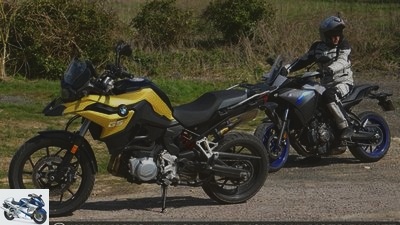
Conversely, the F750 GS requires you to stretch your arms more to grab the handlebars, while its low capacity tank (15 liters against 17 for the Yam ‘) significantly spreads the thighs. In comparison with its Japanese rival slender, the motorcycle from across the Rhine seems massive and long.
The BMW in fact evokes a "big" motorcycle when the Yamaha has the compactness of an average displacement, an observation which benefits accessibility: you easily touch the ground on each side on the Tracer 700, despite its higher saddle ( 840 mm against 815). The German, wider at the crotch, makes pilots less than 1.75 m less comfortable.
In return, the space on board is vast on the F750GS and all sizes find their place. This is not the case on the Tracer 700: the posture is more "grouped", almost too much for a pilot of 1.80 m and more. Blame it on his more hollow saddle and especially his fairly high and set back footrests, which cause a significant bend in the legs. On the BMW, the feet are comfortably placed in the axis of the bust.
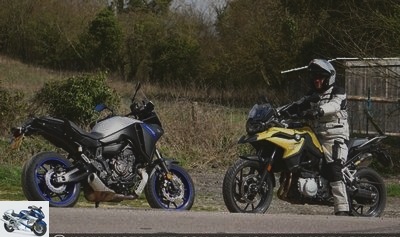
On long distance, the Yamaha nevertheless takes the ascendancy largely thanks to its new saddle which combines wonderfully softness and support: one of our testers rode 3h30 in one go without pain or discomfort. And this on roads not particularly well paved and with a heavy backpack on his shoulders … because he could not be stowed on the optional luggage rack. !
The BMW does less well with its rather firm saddle, without being uncomfortable. It also compensates for its reduced thickness of padding by the infinitely softer absorption of its damping: the new shock absorber settings of the Yamaha effectively give it dry, even brittle reactions, on successions of small irregularities..
The Tracer 700 also boasts its new screen, whose new adjustment mechanism – via a handle – is extremely simple to use with one hand while driving. Too bad the windshield is too short to offer the expected protection: the deflection in the low position stops at the bust and neck, which is ultimately barely better than the "string" style windshield of the F750GS. A shame !
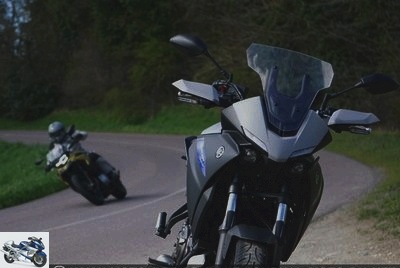
The advantage is more marked in the high position on the Yamaha, but remains insufficient to calmly face the fast tracks: only the chin guard of the helmet of a pilot of 1.75 m is protected, that is to say a third of the face. In addition, the narrow and indented format of the Japanese bubble leaves the shoulders exposed: MNC made the bitter observation in the rain… The BMW unsurprisingly made even worse on this point.
The hand guards of the Tracer 700 – very aesthetic – are hardly more convincing: not enveloping enough and fixed too low, they leave the tops of the hands exposed. Still better than the F750GS with its optional handguards: you said "trail", really ?!
Regarding the lower body, these two trails-GT are on an equal footing: their fairings hide part of the legs, but not enough to repel a downpour. The outside of the knees, the feet and the shins are in the front line in the face of bad weather and the cold: nothing disappointing for these motorcycles with a walking vocation (see the list of practical aspects on page 2).
Engine: the "small" CP2 beats the "big" Sino-German twin !
The mechanical availability of the F750 GS is satisfactory: the block set at 270 ° resumes at 1750 rpm on the first reports without complaining, but is less conciliatory on higher speeds. Driving in fourth at 50 km / h at 2000 rpm in built-up areas is within reach, but no more: the Yamaha does the same thing … in sixth !
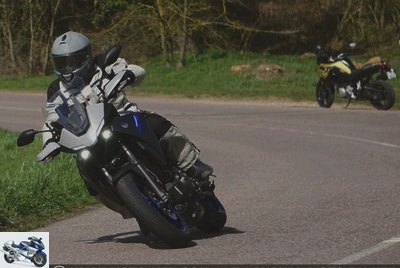
The BMW is not only a little less available, but above all less alert: despite its displacement, the CP2 of the Tracer 700 enjoys an incredibly lively immediate response between 3000 to 5000 rpm! Well done Yamaha for having added two teeth to the crown, as on the Tenere 700 which shares the same MT-07 engine..
- Smart MNC video: Listen to the engines of the F750GS and Tracer 700
At usual speeds, the light Yamaha (196 kg) far distance the heaviest BMW (224 kg) from second to fourth gear despite its torque down (68 Nm against 83). The deal is reversed between 5000 and 7000 rpm, when the "big" twin assembled by Loncin finally decides to make the powder speak while the enthusiasm of the Yamaha decreases.
The Tracer 700 delivers everything at low and mid-range – with stunning panache! -, then begins to lower the roof to 8000 rpm. The German does exactly the opposite: moderately fiery under 5000 rpm, it then delivers a robust, almost sporty push forward, like a kick to the ass. A behavior with two recreational faces in the towers, but quite offset compared to its capacity and its road vocation.
Note that the BMW nevertheless won our recovery test at 90 km / h in sixth thanks to its better staged gearbox, which fills its reach limited to 9,000 rpm (10,500 rpm on the Tracer 700). On the other hand, its rough selection does not facilitate the task of the bi-directional shifter installed as an option. That of the Yamaha, however not exceptionally smooth, is much more pleasant.
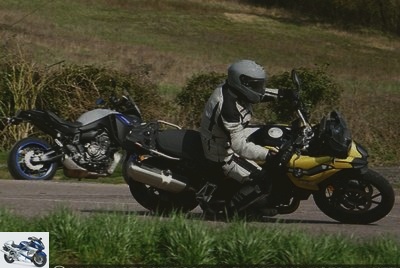
In terms of vibrations, the Yamaha distills light under the buttocks at 5000 rpm, but very bearable compared to those of its rival: the F750GS badly tickles the saddle, the handlebars and the footrests from 4500 rpm ! At high speeds, despite the two balancing pendulums, the image returned by the mirrors is seriously disturbed by these tremors.
The Yam ‘also has a softer "injection-transmission" assembly, very useful for moving smoothly in town and for smooth maneuvers. Note that both motorcycles are chain transmission … but their central stands are optional !
The sound is also to the advantage of the Yamaha, more catchy with its happy jerky tempo which is accompanied by a cheerful groan in the turns. The muffled and monotonous backfiring of the BMW on the contrary evokes a utility motorcycle: not very rewarding.
Cycle part: BMW takes control
28 kg separate the two motorcycles … To this can be added the steering damper of the BMW, its 19-inch wheel and its wiser geometry, which restrict the responsiveness of its front axle. No need to draw you a picture: the F750 GS is incomparably less maneuverable than the Tracer 700 !
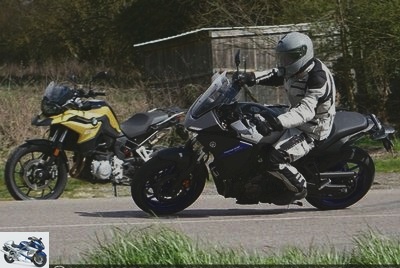
The German requires physical investment with the engine off and at low speed, while the Japanese move effortlessly. The Tracer 700 dives in curves but the F750GS must be pushed there! Its steering seems sticky, a little clumsy: we must also see the downside of its weight gain of 12 kg compared to the old F700 GS, mainly due to the transition from aluminum to steel for its tubular frame.
- Comparo MNC :
The F750GS, less fun and playful, however cuts down the kilometers with a lot of rigor and comfort, well helped by its damping so much higher than that of the Tracer 700. An important aspect on this kind of motorcycles intended to fulfill all Tasks !
Yamaha forced the measure by stiffening its novelty to improve its suspension considered soft. Results: the Tracer 700 is certainly better placed on its spring, but in return shows less progressiveness. In addition, this hardened rear lacks cohesion with the fork remained very flexible: the key, poorly controlled level transfers when braking.
In summary, the 2020 Tracer 700 lacks finesse at the rear and restraint at the front. In addition, in fast driving, its rear axle tends to resist the changes of angle because of the character too "frozen" of its suspension. Fine adjustments to its trigger and preload are to be expected in order to hope to find the right compromise between comfort and rigor, which has escaped Yamaha….
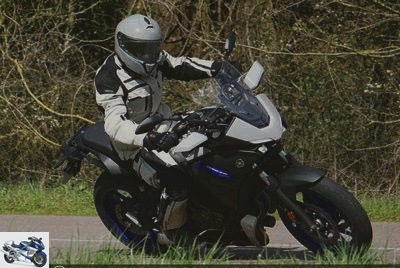
Both smooth and rigorous, the suspensions of the BMW sweep all obstacles with ease and efficiency. As impervious to the vagaries of asphalt, the F750GS is stable, comfortable and considerate: it is essential for long distances, especially as it manages mass transfers to perfection. A real "GS", in short !
Its large difference in terms of "suspension" versatility (yes, it does not exist but it is speaking!) Is even more impressive with its optional ESA electronically controlled damping, which allows you to vary the preload on the handlebars and ” offer different hydraulic support depending on the mode engaged (Road or Dynamic).
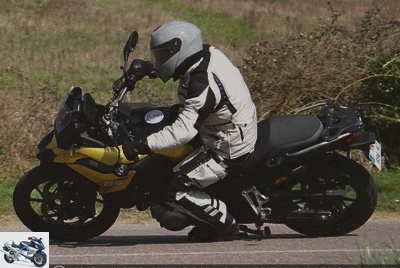
Only downside on the F750GS: its limited ground clearance for a trail, with footrests that quickly come into contact with the asphalt. Be careful not to insist too much at the risk of leveraging a hard point such as the center stand, the selector or the brake pedal … Experience lived by MNC (see sparks above): guaranteed flip! Its rival plays with this constraint with its roadster-style footrests..
Undoubtedly more fun and sporty, the Yamaha drives the point home with its more efficient braking: its 4-piston calipers offer more bite than the 2-piston Brembo of the BMW, which must be actuated firmly to obtain comparable power. The Yamaha rear caliper is also slim and capable, unlike the BMW which is spongy and lazy.
Finish: equality
On the BMW, we regret a low-end engine screws, visible wires in the cockpit or the suspension cylinder placed without grace above the rear footrest. In addition, its color chart is very limited and sad: white as standard, yellow or gray as an option. !
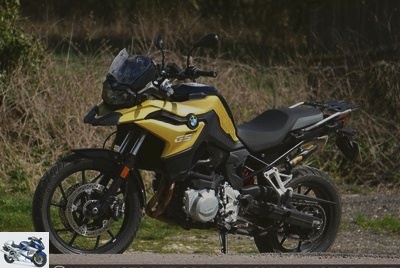
Its elbow valves and braided hose raise the bar nonetheless, as do its adjustable levers and its trunk large enough to accommodate a small U-shaped lock. Not to mention its color instrumentation that is both rewarding, readable and easy to control via the dial on the left stalk. A must !
The Yamaha also blows hot and cold: it exposes a few cables here and there, especially under its lenticular optics. Its stems are basic and the new polished plate on its manifold is not particularly elegant … Its trunk does not reveal any space and a small cover on its injection control would not be luxury.

Its new reinforcement bar on the handlebars – in plastic – on the other hand, brings a touch of "adventurer" in addition to offering a fixing point for GPS, while the eye appreciates its petal discs and its hollow swing arm on the right.
The two ignore the engine spoiler, but the BMW at least offers the possibility of deactivating its traction control and especially its ABS for off-road escapades. In terms of off-roading, the Yamaha "roadstrail" and its non-disengageable ABS are far from equaling its "cousin" Tenere 700 !
Verdict: each has its own trace
The Tracer 700 brings together many favorable arguments to perpetuate its success in 2020 and continue to dominate the segment of versatile road trails (1209 registrations in 2019 against 995 for the F750GS). Its ease of handling, its versatility and its mechanical joie de vivre ensure it victory over its German rival..
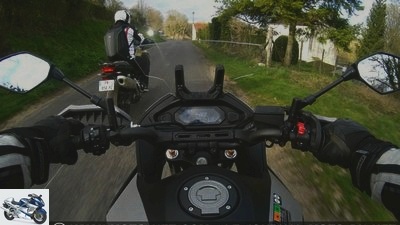
The BMW, however, opposes better damping cohesion and a less restrictive driving position over long distances, especially for large templates. The F750GS ultimately suffers from three handicaps: its inexcusable lack of protection, its high price (€ 10,490 against € 8,799) and its behavior that is certainly effective but erased..
The comparison with the playful Yamaha is striking, both mechanically and dynamically. The F750GS is rigorous but not fun, while the Tracer 700 is funny but insufficiently convincing in terms of damping. The two share in any case a sparrow appetite: 4.76 to 5.09 l / 100 km on the BMW measured by MNC, against 4.38 to 5.51 l / 100 km on the Yamaha. Who says better ?!
MNC regrets, however, that none of them fully meet the specifications of the all-purpose motorcycle: the Tracer 700 comes very close, especially at this price, but it lacks a more generous bubble, a real trunk and above all better coordinated suspensions. Its fantastic engine does not excuse everything !
As for the BMW, in addition to the remarks expressed above, its price constitutes a serious brake: the "full options" motorcycle tested here is close to 14,000 euros (13,830 €) and yet ignores a decent windshield of that name. Ultimately, the late Honda CBF600S and other Bandit 650S offered as much – or more – for less, before the semi-faired roadsters were replaced by the trails-GT.
The main rivals of the F750GS and Tracer 700
- Yamaha Tracer 700: 8,799 euros, inline twin, 73.4 hp, 68 Nm and 196 kg
- BMW F750 GS: 10,470 euros, inline twin, 77 hp, 83 Nm and 224 kg
- Honda NC750X: 9,049 euros (DCT), inline twin, 54.8 hp, 68 Nm and 230 kg
- Honda CB500X: 6,899 euros, inline twin, 47.5 hp, 43 Nm and 197 kg
- Kawasaki Versys 650: 8,049 euros, inline twin, 69 hp, 64 Nm and 217 kg
- Suzuki V-Strom 650: 8,399 euros, V-twin, 71 hp, 63 Nm and 213 kg
Related articles
-
Duel Yamaha Niken GT Vs Tracer 900 GT: the good three (wheels) plan ? A motorcycle is two wheels, a handlebar and a motor. The proof, we have always done…
-
Duel F750 GS Vs Tracer 700: small trails, large road bikes ? New distinct look, improved practical aspects, 689 cc twin cylinder to Euro5 standards: the…
-
Duel Kawasaki Z1000SX 2017 Vs Yamaha Tracer 900: all-in-one The Kawasaki Z1000SX is an excellent sport-GT motorcycle, made even more versatile in 2017…
-
Duel Honda CB650R Vs Yamaha MT-07: chic roadster against shock roadster Exceeding a reference requires either putting on the brakes or taking another…
-
Yamaha Tracer 700 test: small road, big ambitions Six months after the neo-retro XSR700, Yamaha offers a new version of its MT-07: the Tracer 700, with…
-
Test Yamaha Tracer 900 and Tracer 900 GT 2018: the way of wisdom Unclassifiable, the Yamaha Tracer 900? This sporty road bike derived from the stormy…
-
Duel Tracer 900 GT Vs V-Strom 1000 Adventure: services included Yamaha strikes a blow (t) with its Tracer 900 GT 2018 and its ultra complete standard…
-
Duel Tracer 900 GT Vs V-Strom 1000 Adventure: services included Yamaha hits a big blow (t) with its Tracer 900 GT 2018 and its ultra-complete standard…
-
All Tests – Test Yamaha Tracer 700: small road, big ambitions – The small Yamaha road to the test
Yamaha Tracer 700 test: small road, big ambitions Six months after the neo-retro XSR700, Yamaha offers a new version of its MT-07: the Tracer 700, with…
-
Duel Africa Twin Vs V85 TT: the Honda benchmark or the Moto Guzzi revival ? Moto Guzzi is relaunching in 2019 on the (all) terrain of trails with its new…